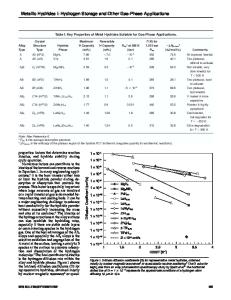Hydrogen Storage: High-Pressure Gas Containment
- PDF / 220,874 Bytes
- 3 Pages / 612 x 792 pts (letter) Page_size
- 17 Downloads / 452 Views
Hydrogen Storage:
High-Pressure Gas Containment R.S. Irani
Abstract This review outlines the prospects for gaseous hydrogen, stored in high-pressure cylinders, as a fuel for automotive applications. Following an initial description of hydrogen embrittlement problems encountered in the past in steel cylinders, the article explores the use of other types of gas cylinders, including the recent examples of hoop-wound and fully wound composites. Central to the article is the concept of the volume of hydrogen transported for the minimum amount of container weight. Finally, the role of international standards in developing safe and efficient cylinders for this application is emphasized. Keywords: carbon–glass hybrids, composite cylinders, hydrogen embrittlement, hydrogen storage, International Organization for Standardization (ISO), liquid-metal embrittlement, ultrasonic testing.
Introduction Hydrogen has been used for several decades as a fuel, albeit primarily in its cryogenic (liquid) form in the space program. The role of hydrogen as a fuel for transportation is now gaining importance because of its clean by-products and good performance when used in internalcombustion engines. The use of gas cylinders for the storage of hydrogen fuel for transportation is a relatively recent application. This article aims, initially, to map the development of cylinder materials and the associated technology relevant to the containment of gaseous hydrogen. Based on this platform of best operating practice, the rest of the article then concentrates on the specific application of certain types of materials and construction methods for such storage containers. Safety apart, the single most important technical factor for this application is the relative weight of the container to that of the hydrogen being contained. This concept is developed fully in the article.
In the Beginning The first known large-scale use of stored compressed hydrogen was in the early 1880s, when British expeditionary troops
680
used hydrogen, transported in wroughtiron welded vessels, to inflate war balloons in Asia and Africa. These vessels weighed in excess of 500 kg, which reflected the thick cylinder walls necessitated by the low tensile strength of the wrought iron (about 350 MPa); their gas capacity was only 25 m3. This represented a technical efficiency for the vessels of just 0.05 m3/kg, as measured by the volume of hydrogen carried per unit weight of the container. Subsequently, cylinder technology has moved rapidly, with advances in both the materials of construction and manufacturing technology.
Early Material Developments With major developments in steelmaking technology in the early to mid-20th century, the technical efficiency of hydrogen cylinders rapidly increased. The earlier high/low carbon steels were followed by carbon manganese steels in the 1940s, only to be replaced by low-alloy steels with additions of about 1% Cr and 0.2% Mo in the mid-1960s. At each step, the technical efficiency of the resulting cylinders rose, so that by the time
Data Loading...











